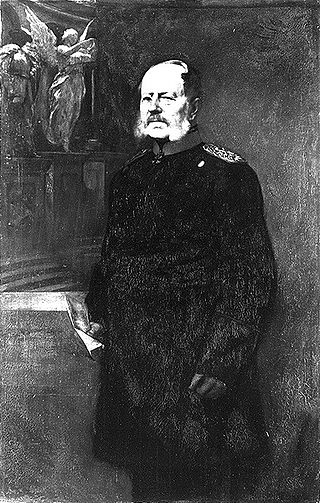
Karl Eberhard Herwarth von Bittenfeld was a Prussian Generalfeldmarschall. He served in many military conflicts throughout the 19th century and was given major commands throughout each conflict.

The Royal Order of the Crown was a Prussian order of chivalry. Instituted in 1861 as an honour equal in rank to the Order of the Red Eagle, membership could only be conferred upon commissioned officers, but there was a medal associated with the order which could be earned by non-commissioned officers and enlisted men.

The Order of the Red Eagle was an order of chivalry of the Kingdom of Prussia. It was awarded to both military personnel and civilians, to recognize valor in combat, excellence in military leadership, long and faithful service to the kingdom, or other achievements. As with most German other European orders, the Order of the Red Eagle could be awarded only to commissioned officers or civilians of approximately equivalent status. However, there was a medal of the order, which could be awarded to non-commissioned officers and enlisted men, lower ranking civil servants and other civilians.
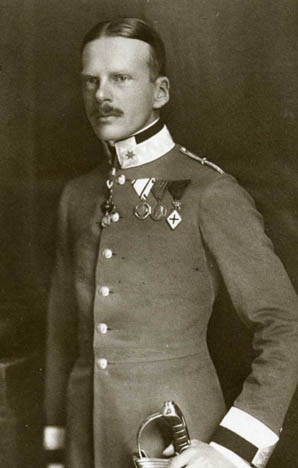
Prince Georg of Bavaria was a member of the Bavarian Royal House of Wittelsbach and a Catholic priest.
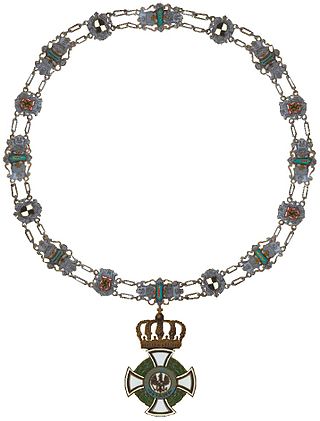
The House Order of Hohenzollern was a dynastic order of knighthood of the House of Hohenzollern awarded to military commissioned officers and civilians of comparable status. Associated with the various versions of the order were crosses and medals which could be awarded to lower-ranking soldiers and civilians.
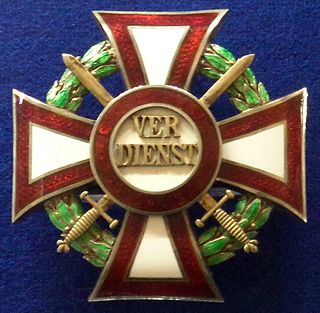
The Military Merit Cross was a decoration of the Empire of Austria and, after the establishment of the Dual Monarchy in 1867, the Empire of Austria-Hungary. It was first established on October 22, 1849 and underwent several revisions to its design and award criteria over the years of its existence. It became obsolete in 1918 with the dissolution of the Austro-Hungarian Empire.

The Bavarian Military Merit Cross (Militär-Verdienstkreuz) was that kingdom's main decoration for bravery and military merit for enlisted soldiers. It was intended "to reward extraordinary merit by non-commissioned officers, soldiers, and lower-ranking officials." It was originally established on 19 July 1866 as the 5th Class of the Military Merit Order, which was the main decoration for bravery and military merit for officers and higher-ranking officials. Civilians acting in support of the army were also made eligible for the decoration.
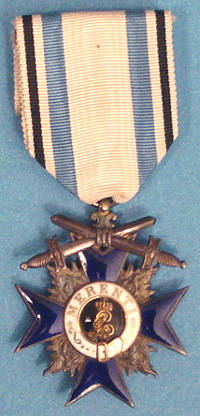
The Bavarian Military Merit Order was established on 19 July 1866 by King Ludwig II of Bavaria. It was the kingdom's main decoration for bravery and military merit for officers and higher-ranking officials. Civilians acting in support of the army were also made eligible for the decoration. The Military Merit Order ranked below the Military Order of Max Joseph (Militär-Max-Joseph-Orden), which was Bavaria's highest military honor for officers.

The House and Merit Order of Duke Peter Frederick Louis or proper German Oldenburg House and Merit Order of Duke Peter Frederick Louis was a civil and military order of the Grand Duchy of Oldenburg, a member state of the German Empire. The order was founded by Grand Duke Augustus of Oldenburg on 27 November 1838, to honor his father, Peter Frederick Louis of Oldenburg. It became obsolete in 1918 after the abdication of the last grand duke.

Prince Konrad of Bavaria was a member of the Bavarian Royal House of Wittelsbach.

George Victor was the 3rd sovereign Prince of the German state of Waldeck and Pyrmont.
Colombian military decorations date back as far as the founding of the country. An early decoration was the Cruz de Boyacá that was awarded to the generals who led their forces to victory in the Battle of Boyacá in 1819. This early decoration lives on today as an incarnation of the highest order presented by the Colombian state. There is one decoration higher, but it is only awarded for military conflicts in defence of Colombia. Other than military decorations, Colombia presents decorations on behalf of the National Government, decorations for the National Police, and decorations from the Congress of Colombia.

The Order of the Württemberg Crown was an order of chivalry in Württemberg.

William Frederick, Prince of Wied was a German nobleman, eldest child of William, Prince of Wied. He was an elder brother of William, Prince of Albania.
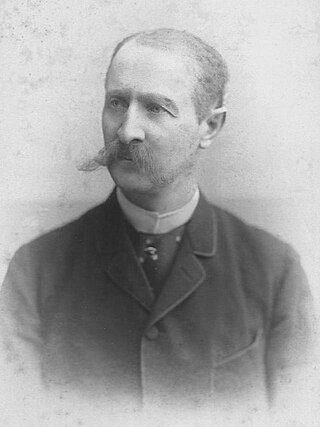
Alexis was a lieutenant general, statesman, and the Prince of Bentheim and Steinfurt from 28 September 1890 to 21 January 1919.
This is a list of orders, decorations, and medals of Austria-Hungary.

The Military Honor Medal was a two-class military decoration awarded by the Kingdom of Prussia. The medal was awarded to military personnel from the rank of sergeant and below. Established in 1814, it replaced the Gold Military Merit Medal of 1806, with a medal in the shape of a cross silver cross for the 1st class while the Silver Military Medal of 1806 became the 2nd class with minor changes in design.

The House Order of Henry the Lion In German: Hausorden Heinrichs des Löwen, was the House Order of the Duchy of Brunswick. It was instituted by William VIII, Duke of Brunswick on 25 April 1834. The ribbon of the Order was red with yellow edges. It had five grades: Grand Cross, Grand Commander with Sash, Commander, Knight 1st Class, Knight 2nd Class, plus Medal of Merit for Science and Arts, the Cross of Merit and the Medal of Honour. The Order was named in honour of Henry the Lion, who remains a popular figure to this day.

The Order of Merit of Philip the Magnanimous was an order of chivalry established by Louis II, Grand Duke of Hesse on 1 May 1840, the name day of Philip I, Landgrave of Hesse, in his honour to award extraordinary military or civil merit. It was the second-highest order of the Grand Duchy of Hesse before 1876, when it was displaced to third by the revived Order of the Golden Lion, the former paramount order of the Electorate of Hesse.

The Princely Reuss Honour Cross was an Order of merit common to the principalities of Reuss Junior line and Reuss Elder line. It was founded by Heinrich XIV, Prince Reuss Younger Line in 1869, and in 1902 became a state order of the Elder Line Principality as well.



















